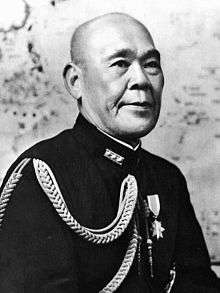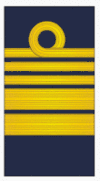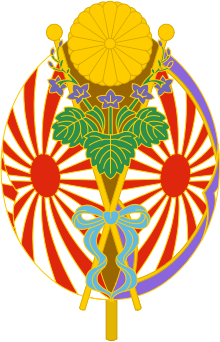Osami Nagano
Osami Nagano (永野 修身, Nagano Osami, June 15, 1880 – January 5, 1947) was a Japanese Marshal Admiral and one of the heads of Japan's military leadership during most of the Second World War. From April 1941 to February 1944, he served as Chief of the Imperial Japanese Navy General Staff. He also was the founder of the Chiba Institute of Technology. After the war, Nagano was arrested by the International Military Tribunal for the Far East but died of natural causes in prison during the trial.
Osami Nagano | |
|---|---|
永野 修身 | |
 | |
| Minister of the Imperial Japanese Navy | |
| In office 9 March 1936 – 2 February 1938 | |
| Monarch | Shōwa |
| Prime Minister | Koki Hirota |
| Preceded by | Ōsumi Mineo |
| Succeeded by | Yonai Mitsumasa |
| Chief of the Imperial Japanese Navy General Staff | |
| In office 9 April 1941 – 21 February 1944 | |
| Prime Minister | |
| Preceded by | Prince Fushimi Hiroyasu |
| Succeeded by | Shimada Shigetarō |
| Personal details | |
| Born | June 15, 1880 Kōchi, Kōchi Prefecture, Japan |
| Died | January 5, 1947 (aged 66)[1] Sugamo Prison, Tokyo, Japan |
| Awards |
|
| Military service | |
| Allegiance | Empire of Japan |
| Branch/service | Imperial Japanese Navy |
| Years of service | 1900–1947 |
| Rank | Marshal Admiral |
| Commands |
|
| Battles/wars | World War I, World War II |
Biography
Nagano was born in Kōchi to an ex-samurai family. In 1900, he graduated from the 28th class of the Imperial Japanese Naval Academy, ranked second in his class of 105 cadets. After midshipman service on the cruiser Hashidate and battleship Asahi, he was commissioned an ensign and assigned to the cruiser Asama. During the Russo-Japanese War, he served in a number of staff positions. The closest he came to combat was as commander of a land-based heavy naval gun unit during the siege of Port Arthur.
After his promotion to lieutenant in 1905, Nagano served on the battleship Shikishima. From 1905 to 1906, he studied naval artillery and navigation. From 1906 to 1908, he was chief gunnery officer on the cruiser Itsukushima. In 1909, he graduated from the Japanese Naval War College.
In 1910, Nagano was promoted to lieutenant commander and assigned as chief gunnery officer on the battleship Katori. From January 1913 to April 1915, he was a language officer in the United States, during which time he studied at Harvard Law School.
During World War I, Nagano was executive officer on the cruisers Nisshin and cruiser Iwate. In 1918, he was promoted to captain. In 1919, he received his first (and only) ship command, the cruiser Hirado.[3]
From December 1920, Nagano was a military attaché to the United States, in which capacity he attended the Washington Naval Conference. In November 1923, he returned home, although he returned to the United States on official visits in 1927 and 1933. In December 1923, he was promoted to rear admiral.
In February 1924, Nagano was chief of the Imperial Japanese Navy General Staff Third Section (Intelligence). From December 1924, he commanded the 3rd Battleship Division. From April 1925, he commanded the 1st China Expeditionary Fleet. In December 1927, he was promoted to vice admiral.
From 1928 to 1929, Nagano was commandant of the Imperial Japanese Naval Academy. Nagano introduced and influenced Progressive education method such as Dalton Plan to Japanese Naval Academy.[4]
From 1930 to 1931, he was vice chief of the Navy General Staff, in which capacity he attended the Geneva Naval Conference. He attended the London Naval Conference 1930. From 1933 to 1934, he was commander in chief of the Yokosuka Naval District. On 1 March 1934, he was promoted to admiral and appointed to the Supreme War Council. Nagano was the chief naval delegate to the London Naval Conference 1935. Japan withdrew in protest from the 1935 London Conference after it was denied naval parity with the United States and Great Britain.
In 1936, Nagano was appointed Navy Minister under Prime Minister Kōki Hirota. In 1937, he was appointed Combined Fleet commander-in-chief.
From 1941, Nagano was chief of the Imperial Japanese Naval General Staff, serving as the most senior officer in the Japanese navy during most of World War II. However, he did not provide strong leadership and entrusted too much strategic planning to hard-line subordinates.[5] Although he was a proponent of the Nanshin-ron, he was against war with the United States. Nagano pretended to go south in order to avoid the Japanese Army from participating in the war between Germany and the Soviet Union. He tried to avoid Japan waging war with the Soviet Union and the United States. On July 30, 1941, when the US announced the petroleum embargo, he met Emperor Showa and said that Japan is not likely to win even if fighting. Nagano urged for Japan's alliance with Germany to be annulled, but Emperor Hirohito refused because it would go against international fidelity. At a conference on November 1, 1941, Osami Nagano proposed an anti-war plan, but this was struck down by Prime Minister Tojo Hideki.[6] [7]. He concluded that if Japan were able to take over British and Dutch colonies in Asia without directly attacking the United States, the isolationist factions with the American government would prevent the United States from declaring war against Japan. He was against Admiral Isoroku Yamamoto's planned attack on Pearl Harbor, but reluctantly gave his approval for the attack after Yamamoto threatened to resign as Combined Fleet commander.[8]
In 1943, Nagano was promoted to marshal admiral. By 1944, however, Japan had suffered serious military setbacks and Nagano had lost the confidence of Emperor Hirohito.[9] With the emperor's approval, Prime Minister Hideki Tōjō and Navy Minister Shigetarō Shimada removed Nagano from his post and replaced him. Nagano spent the remainder of the war as an advisor to the government.
Remark
- According to the opinion of the Japanese government, if Japan accepts the demand of the United States, Japan will perish. However, even if Japan fights against the United States, Japan may perish. That is, accepting the request of the United States will destroy Japan without fighting the United States. Even if we fight against the United States, if Japan can not avoid the danger of extinction, if Japan defeats without fighting with the United States, the Japanese people will truly disappear from the earth. However, if Japanese people can fight and show the spirit of defending Japan, even if Japan fights against America, our descendants will always rebuild Japan. We hope to solve problems in diplomatic negotiations. But unfortunately we will be fighting if we are to be commanded to wage war.(September 6, 1941, Osami Nagano)[10]
War crimes trial
After World War II in 1945, the American Occupation forces arrested Nagano. He was charged with Class A war criminal charges before the International Military Tribunal for the Far East in Tokyo. When US naval officers interrogated him, he was described as "thoroughly cooperative," "keenly alert," "intelligent," and "anxious to develop American friendship."[11] The last Fleet Admiral of the Imperial Japanese Navy, he died of a heart attack due to complications arising from pneumonia in Sugamo Prison in Tokyo before the conclusion of his trial.
Naval career
| IJN Insignia | Rank | Date |
|---|---|---|
.png) |
海軍少尉候補生 Kaigun Shōi Kōhōsei (Midshipman) |
13 December 1900 |
.gif) |
海軍少尉 Kaigun Shōi (Ensign) |
18 January 1902 |
.gif) |
海軍中尉 Kaigun Chūi (Sub-Lieutenant/Lieutenant Junior Grade) |
26 September 1903 |
 |
海軍大尉 Kaigun Daii (Lieutenant) |
12 January 1905 |
.gif) |
海軍少佐 Kaigun Shōsa (Lieutenant-Commander) |
1 December 1910 |
 |
海軍中佐 Kaigun Chūsa (Commander) |
1 December 1914 |
 |
海軍大佐 Kaigun Daisa (Captain) |
1 December 1918 |
 |
海軍少将 Kaigun Shōshō (Rear-Admiral) |
1 December 1923 |
 |
海軍中将 Kaigun Chūjō (Vice-Admiral) |
1 December 1927 |
 |
海軍大将 Kaigun Taishō (Admiral) |
1 March 1934 |
 |
元帥海軍大将 Gensui Kaigun Taishō (Marshal-Admiral) |
21 June 1943 |
References
Books
- D'Albas, Andrieu (1965). Death of a Navy: Japanese Naval Action in World War II. Devin-Adair Pub. ISBN 0-8159-5302-X.
- Dull, Paul S. (1978). A Battle History of the Imperial Japanese Navy, 1941-1945. Naval Institute Press. ISBN 0-87021-097-1.
- Evans, David (1979). Kaigun: Strategy, Tactics, and Technology in the Imperial Japanese Navy, 1887-1941. US Naval Institute Press. ISBN 0-87021-192-7.
- Parshall, Johnathan (2005). Shattered Sword: The Untold Story of the Battle of Midway. Potomac Books. ISBN 1-57488-923-0.
- Tucker, Spencer C (2011). World War II at Sea:An Encyclopedia. ABC-Clio Inc. ISBN 978-1-59884-457-3.
| Wikimedia Commons has media related to Osami Nagano. |
External links
- Chen, Peter. "Nagano Osami". World War II Database. Retrieved 2007-08-03.
- Nishida, Hiroshi. "Materials of IJN: Nagano, Osami". Imperial Japanese Navy. Retrieved 2007-08-03.
- United States Strategic Bombing Survey. "Interrogations of Japanese officials". Retrieved 2007-08-03.
- "How Japs Fight". Time. 1943-02-15. Retrieved 2008-08-14.
- Brannon, John G. "John G. Brannon Papers". Georgetown Law Library Manuscripts Collection. hdl:10822/555530.
Notes
- Nishida, Imperial Japanese Navy
- Nagano Osami at navalhistory.flixco.info
- Tucker, World War II:An Encyclopedia, page 529
- JapaneseBOOK”戸高一成『証言録 海軍反省会』2009”
- Parshall, Shattered Sword
- Japanese book,”鳥居民『山本五十六の乾坤一擲』”
- JapaneseBOOK”Takushiro Hattori『大東亜戦争全史』1969”
- Evans. Kaigun. page 528-529
- D’Abas, Death of a Navy
- JapaneseBOOK”Toshio Motoya『【増補版】理論近現代史学 本当の日本の歴史』2017”
- USSBS, Interrogations of Japanese Officials